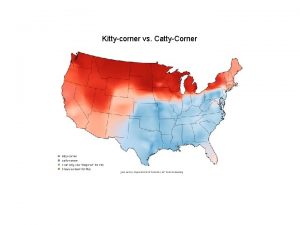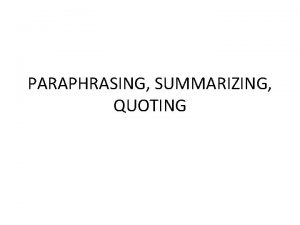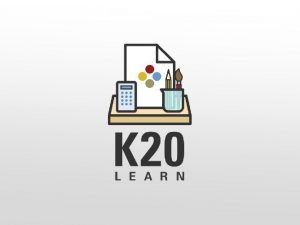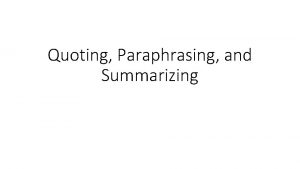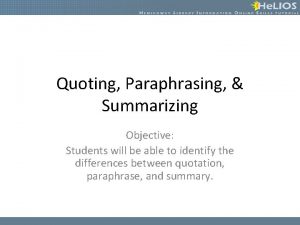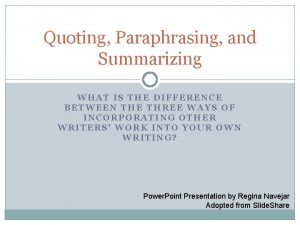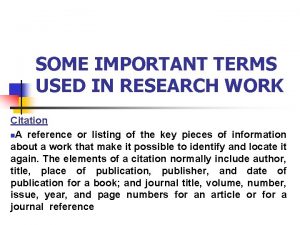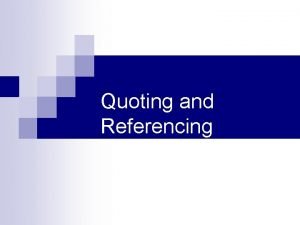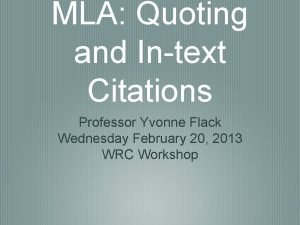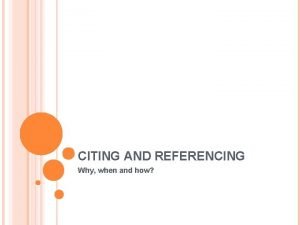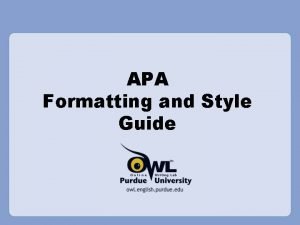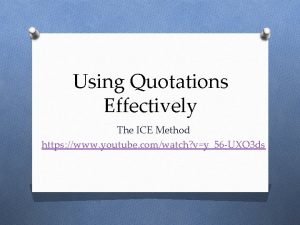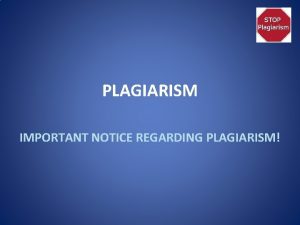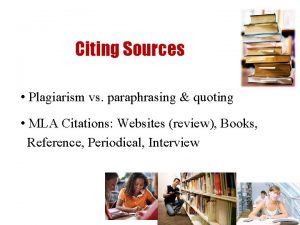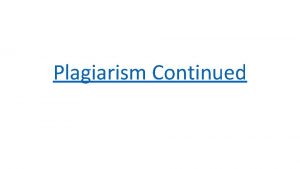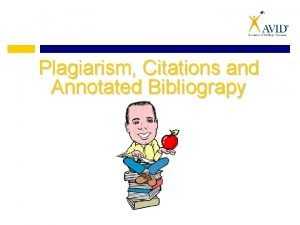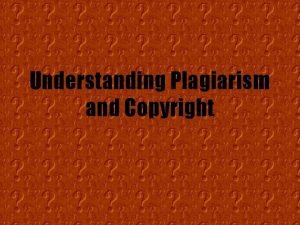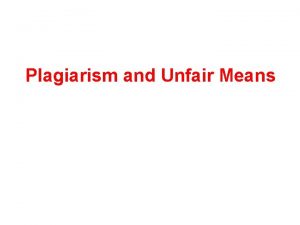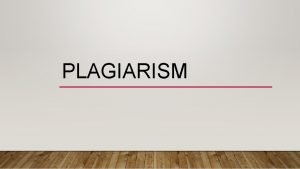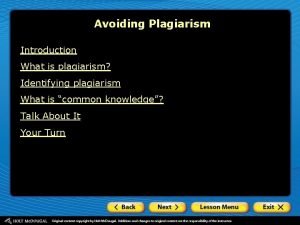WRITING CORNER 4 Citations and Quoting Plagiarism Taking















- Slides: 15

WRITING CORNER #4 Citations and Quoting

Plagiarism • Taking ideas or wording from another source without giving credit to that source • Shows disrespect to the original source and is considered a form of academic dishonesty • Can be solved by citing the original source in your writing

When to cite? • Direct quotes: a testimony from an authority, when the wording is precise, or could not be phrased any better • Statistics and Studies • Theories • Paraphrases: expressing the same meaning with your own wording

How to cite: 1) In text citations throughout the paper 2) Reference page at the end of a paper • In-text citations help readers locate the cited source in the References section of the paper.

In text citations throughout the paper • When referencing a general study, book, or theory, format like this (author’s last name, year of publication) • When directly quoting or paraphrasing someone else’s thought, add a page number year, p. #) (author’s last name, • If author is unknown, put the first word found on the Reference page instead • This information can be put in (parenthesis) or included in the sentence.

Reference page at the end of a paper • • Center the title (References) at the top of the page. Do not bold it. Double-space reference entries • Flush left the first line of the entry and indent subsequent lines • Order entries alphabetically by the surname of the first author of each work

Sample Reference Page References American Association for Artificial Intelligence. (2001, March). Retrieved from http: //www. aaai. org Bernstein, B. J. Atomic diplomacy: Hiroshima and Nagasaki. Diplomatic History, 28 (3), 126 -129. Jackson, G. (2004). Multiple historic meanings of the Spanish civil war. Science and Society, 68(3), 272 -276. Retrieved from the Lexis Nexis Academic database. Van Delay, A. (1994). Venetian blinds: Contemporary study of compulsive lying. New York: Pendant Publishing.

The Reference page comes at the end of the paper. Any source cited in the paper, must be included on the Reference page!

Quick Quiz time

What, if anything, is wrong with this student’s citation? In 1904, Matisse came under the influence of Signac's use of separated colours in his paintings. This was called "divisionism. " As Spurling says: "Divisionism provided logical grounds for separating the ultimate goal of painting - order, harmony, emotional stability achieved through rhythmic compositions of form and colour from its traditional dependence on the subject. This was an important idea for Matisse. A) I don't see anything wrong. The student used appropriate citation. B) Although we can see where the student began to use information from another source, the citation is incomplete.

B) It should have been: • In 1904, Matisse came under the influence of Signac's use of separated colours in his paintings. This was called "divisionism. " As Spurling says: "Divisionism provided logical grounds for separating the ultimate goal of painting - order, harmony, emotional stability achieved through rhythmic compositions of form and colour from its traditional dependence on the subject" (1995, p. 285). This was an important idea for Matisse.

Is this a good use of quotation? Gergely Nagy (2001), in his article "Saving the Myths: The Re-creation of Mythology in Plato and Tolkien" talks about light and vision imagery as being a common thread in both authors' works, and suggests that they lead to "opportunity" (p. 93) for many uses. A) No, but it is cited correctly B) Yes, but it isn’t cited correctly C) yes, and it is cited correctly

A) • One should only quote when the text quoted is important, a necessary quote by a learned authority in the field, when it could not be said more concisely, or when it could not be said in a more effective way. The word "opportunity" is not an important word; another word with the same sense can easily replace it, and it is not particularly effective for our student's purposes. • The citation is correct though!

Is this correct paraphrasing? Original: To the extent that a woman's self-image is challenged or threatened by an unattainable ideal of an impossibly thin female physique, she may well become susceptible to disruption of her self-regard, and may be more likely to develop an eating disorder. Paraphrased: If a woman interprets the media's representation of thinness as the ideal she must achieve, her sense of self-esteem might be threatened and even damaged, making her more likely to exhibit disordered eating patterns (Polivy & Herman, 2004). A) Correct B) Incorrect

A) • This is correct. They have maintained the meaning of the original text, but put it into their own words and voice. They have also given the authors credit and provided the publication date.
 Catty corner vs kitty corner
Catty corner vs kitty corner Try to practice paraphrasing summarizing and direct quoting
Try to practice paraphrasing summarizing and direct quoting 4-2 reading quoting paraphrasing and summarizing
4-2 reading quoting paraphrasing and summarizing Quoting summarizing and paraphrasing
Quoting summarizing and paraphrasing Direct material sourcing and quoting
Direct material sourcing and quoting Quoting, paraphrasing and summarizing examples
Quoting, paraphrasing and summarizing examples Compare paraphrasing summarizing and direct quoting
Compare paraphrasing summarizing and direct quoting How to write citation with 3 authors
How to write citation with 3 authors Quoting dialogue
Quoting dialogue How to cite shakespeare
How to cite shakespeare Mla quote
Mla quote Quoting articles
Quoting articles Quoting multiple authors apa
Quoting multiple authors apa Quote analysis sentence starters
Quote analysis sentence starters Quoting software for distributors
Quoting software for distributors Ice method
Ice method
